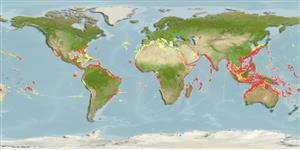(كوسه ها و سپرماهيان) (sharks and rays) >
Carcharhiniformes (Ground sharks) >
Carcharhinidae (Requiem sharks)
Etymology: Carcharhinus: karcharos (Gr.), sharp or jagged; rhinus, an ancient name for sharks, from rhine (Gr.), rasp, both words alluding to a shark's jagged, rasp-like skin (See ETYFish); altimus: Latin for highest, allusion not explained nor evident (See ETYFish).
Environment: milieu / climate zone / depth range / distribution range
بوم شناسي
دريايي وابسته به آب سنگ; تغييرات عمق 12 - 810 m (Ref. 58302), usually 80 - 220 m (Ref. 9253). Subtropical; 46°N - 31°S, 180°W - 180°E
Circumglobal: tropical to temperate watersin the Atlantic, Pacific and Indian oceans. Introduced in the Mediterranean via Gibralltar.
Length at first maturity / Size / Weight / سن
Maturity: Lm 230.0, range 205 - 282 cm
Max length : 300 cm TL جنس نر / بدون خواص جنسي; (Ref. 2334); common length : 250 cm TL جنس نر / بدون خواص جنسي; (Ref. 26999); بيشينه وزن گزارش شده: 167.8 kg (Ref. 40637)
خارهاي باله پشتي (کل) : 0; خارهاي باله مخرجي: 0. A heavily-bodied, cylindrical shark with a large, long and broad snout, long nasal flaps and high, triangular, saw-edged upper teeth; interdorsal ridge high and prominent; pectoral and dorsal fins large and straight (Ref. 5578). Grayish with no conspicuous markings, white below (Ref. 5578); inner corners of pectoral fins blackish (Ref. 9997).
Found near the edge of the continental and insular shelves and uppermost slopes (Ref. 244). Rare in shallow waters (Ref. 9997), bottom associated near shelf breaks and drop-offs; young may occur at 25 m (Ref. 58302). Feeds on bony fishes, other sharks, stingrays, and cuttlefish (Ref. 244). Viviparous (Ref. 50449). Utilized for fishmeal, liver oil, and shagreen (Ref. 9997). Minimum depth reported taken from Ref. 244.
Life cycle and mating behavior
بلوغ | تولید مثل | تخم ریزی | تخم ها | Fecundity | توزاد ( لارو)
Viviparous, placental (Ref. 50449). Gives birth every second year with 1-13 (average 9) pups per litter (Ref. 58048). In the Mediterranean, sharks give birth in August and September, however in Madagascar, young are born in September and October (Ref. 244). Size at birth 60-75 cm (Ref. 6871); 70-90 cm TL (Ref.58048). Distinct pairing with embrace (Ref. 205).
Compagno, L.J.V., 1984. FAO Species Catalogue. Vol. 4. Sharks of the world. An annotated and illustrated catalogue of shark species known to date. Part 2 - Carcharhiniformes. FAO Fish. Synop. 125(4/2):251-655. Rome: FAO. (Ref. 244)
وضعيت در فهرست قرمز IUCN (Ref. 130435: Version 2024-2)
استفاده انسانی
ماهي گيري – شيلات: ارزش تحاري اندك; ماهي ها ي سرگرم كننده: بله
ابزارها
گزارش های ويژه
بارگيری XML
منابع اينترنتي
Estimates based on models
Preferred temperature (Ref.
123201): 13.8 - 26.5, mean 19.9 °C (based on 875 cells).
Phylogenetic diversity index (Ref.
82804): PD
50 = 0.5000 [Uniqueness, from 0.5 = low to 2.0 = high].
Bayesian length-weight: a=0.00372 (0.00222 - 0.00621), b=3.08 (2.94 - 3.22), in cm total length, based on LWR estimates for this species & Genus-body shape (Ref.
93245).
Trophic level (Ref.
69278): 4.5 ±0.3 se; based on diet studies.
جهندگی (Ref.
120179): خیلی آهسته, كمينه زمان لازم براي دو برابر شدن جمعيت بيش از 14 سال (Fec=1-13;).
Fishing Vulnerability (Ref.
59153): Very high vulnerability (90 of 100).
Nutrients (Ref.
124155): Calcium = 2.96 [0.55, 15.71] mg/100g; Iron = 0.338 [0.086, 0.978] mg/100g; Protein = 22.9 [20.0, 25.1] %; Omega3 = 0.186 [0.069, 0.461] g/100g; Selenium = 24 [8, 71] μg/100g; VitaminA = 26.4 [9.0, 79.0] μg/100g; Zinc = 0.305 [0.149, 0.601] mg/100g (wet weight);
